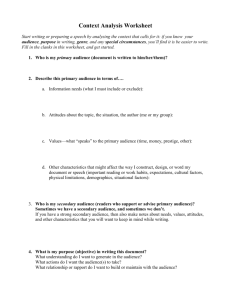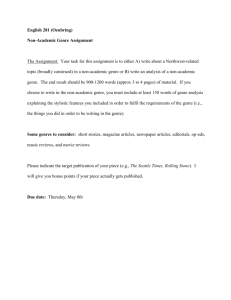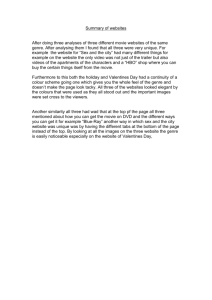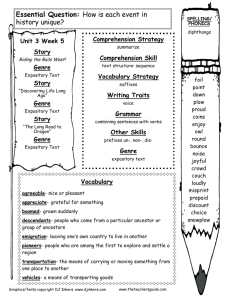Imitatio Analysis Heuristic
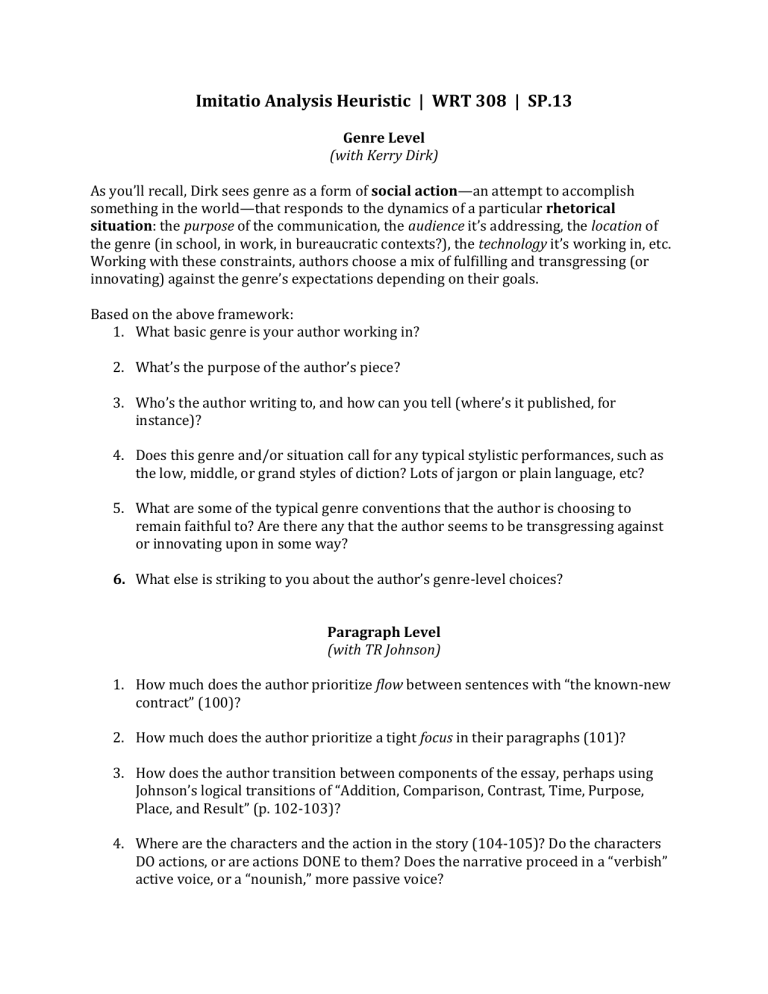
Imitatio Analysis Heuristic | WRT 308 | SP.13
Genre Level
(with Kerry Dirk)
As you’ll recall, Dirk sees genre as a form of social action—an attempt to accomplish something in the world—that responds to the dynamics of a particular rhetorical
situation: the purpose of the communication, the audience it’s addressing, the location of the genre (in school, in work, in bureaucratic contexts?), the technology it’s working in, etc.
Working with these constraints, authors choose a mix of fulfilling and transgressing (or innovating) against the genre’s expectations depending on their goals.
Based on the above framework:
1.
What basic genre is your author working in?
2.
What’s the purpose of the author’s piece?
3.
Who’s the author writing to, and how can you tell (where’s it published, for instance)?
4.
Does this genre and/or situation call for any typical stylistic performances, such as the low, middle, or grand styles of diction? Lots of jargon or plain language, etc?
5.
What are some of the typical genre conventions that the author is choosing to remain faithful to? Are there any that the author seems to be transgressing against or innovating upon in some way?
6.
What else is striking to you about the author’s genre-level choices?
Paragraph Level
(with TR Johnson)
1.
How much does the author prioritize flow between sentences with “the known-new contract” (100)?
2.
How much does the author prioritize a tight focus in their paragraphs (101)?
3.
How does the author transition between components of the essay, perhaps using
Johnson’s logical transitions of “Addition, Comparison, Contrast, Time, Purpose,
Place, and Result” (p. 102-103)?
4.
Where are the characters and the action in the story (104-105)? Do the characters
DO actions, or are actions DONE to them? Does the narrative proceed in a “verbish” active voice, or a “nounish,” more passive voice?
Author Style Analysis Rubric | 2
Sentence Level
(with TR Johnson & Hawhee/Crowley)
1.
What figures or tropes do you see in the author’s prose? Even if you don’t remember the names of the tropes, what patterns do you notice that seem significant?
2.
What patterns of sentence construction do you see? Are they largely paratactic
(coordinated), or are they hypotactic (with subordinate construction) in their construction? The Running Style (list-making or stream of consciousness or the
Periodic Style (longer, subordinated clauses, with the sentence’s “payoff” or meaning delayed until the end)?
3.
What, if any, techniques do you see the author employing to create emphasis in their prose (Johnson, 106-112)?
4.
What, if any, techniques has the author employed to create persuasive balance and/or contrast (Johnson, 112-114)?
5.
What figurative language does the author employ, and for what effect (Johnson, 114-
117)?
6.
What else strikes you at sentence-level?
Worthy of Emulation
1.
Given your project’s subject matter and social action goals, what genre, paragraph, and sentence-level choices make sense for you to emulate?
2.
What features MUST you emulate in order for your style to be a recognizable
“imitatio” of this author’s piece?


